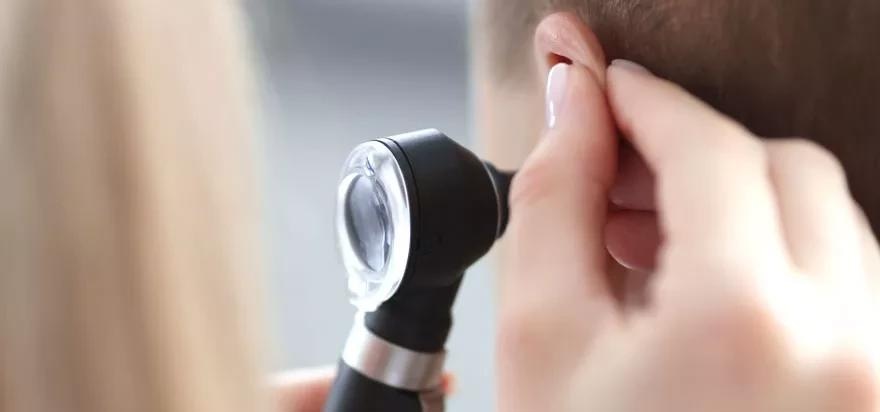Before performing audiometry, tympanometry, or any other ear-related procedure, a clinician or healthcare professional will typically perform an otoscopy. Otoscopy is a clinical procedure employed to visually inspect the structures of the ear, especially the External Auditory Canal (EAC) and Tympanic Membrane (TM).

Image Credit: Amplivox UK
It also offers some insight into the condition of the middle ear (ME), although to a lesser extent. Clinicians utilize an otoscope as part of routine wellness physical examination and when assessing specific ear complaints.
What is an otoscope?
An otoscope is comprised of a light, a magnifying lens, and a funnel-shaped viewing piece with a narrow, pointed end known as a speculum. The light beam is directed through the otoscope into the ear canal.
Otoscopy can be conducted using either manual or digital otoscopes. A manual otoscope can be employed independently since the optic and the light source are contained within a single handheld unit.
A digital otoscope retains the components within a handheld unit but displays the image of the ear on a screen. This offers additional advantages as it enables the user to capture and document the otoscopy, or even present the image in real-time to the patient.
Why is otoscopy important?
In an optimal testing situation, the ear canal should be clear and unobstructed to enable the transmission of acoustic energy (sound) and applied air pressure through the tympanic membrane, middle ear, and inner ear.
In the testing environments specified, achieving ‘an ideal’ scenario is not always possible. Obstacles, such as ear wax build-ups, skin debris, fluids like pus, or foreign bodies, may be present in the ear canal.
Not only does otoscopy serve the purpose of ensuring the pathway to the eardrum is unobstructed, but also it provides a comprehensive assessment of the overall condition of the ear canal and tympanic membrane.
It helps identify abnormalities such as a perforated eardrum, middle ear effusion, swelling or redness of the ear canal, infection, or other issue.
How is otoscopy performed?
During otoscopy, the clinician inserts the speculum into the patient’s ear and maneuvers it in different directions to examine the condition of the external auditory canal (EAC) and tympanic membrane (TM). To obtain a clearer view, the clinician will gently pull the pinna upward and backward to straighten the ear canal.
This maneuver aligns the acoustic meatus with the canal, facilitating the observation of landmarks within the ear and assessing the overall health condition of the EAC and TM. This procedure is quick and painless and a crucial part of an auditory examination. Here are the steps to conduct otoscopy:
- Arrange the equipment: Make sure that the otoscope is clean and has a functional light source. Attach a disposable speculum if needed.
- Position the patient: Instruct the patient to sit upright and tilt their head towards the opposite shoulder for better exposure to the ear canal.
- Inspect the external ear: To examine the external part of the ear for any signs of inflammation, discharge, or foreign objects, use your fingers or the otoscope.
- Insert the otoscope: Using your dominant hand, hold the otoscope and carefully insert the speculum into the ear canal, stabilizing the patient's head with the other hand. Be cautious not to insert the otoscope too deeply or vigorously.
- Observe the ear canal and eardrum: Visualize the ear canal and eardrum using the otoscope's magnifying lens and light source. Look for redness, swelling, discharge, or other abnormalities.
- Remove the otoscope: After completing the examination of the ear, gently withdraw the otoscope from the ear canal.
- Repeat the process: If necessary, repeat the same process on the other ear.
Being gentle and patient during the otoscopy procedure is crucial to prevent discomfort or injury to the patient.
References and further reading
The British Society of Audiology (2022). Recommended Procedure – Ear Examination [Online]. Accessible at: https://www.thebsa.org.uk/wp-content/uploads/2023/10/OD104-54-BSA-Recommended-Procedure-Ear-Examiniation-February-2022.pdf
About Amplivox
Amplivox creates a healthier future by providing accessible and accurate medical solutions for everyone.
As a manufacturer with more than 90 years of experience, we are proud to be a trusted partner to hearing and occupational health professionals all over the world by delivering a high level of knowledge-led solutions, service and support. We are here to be your preferred audiological and occupational health equipment provider.
Sponsored Content Policy: News-Medical.net publishes articles and related content that may be derived from sources where we have existing commercial relationships, provided such content adds value to the core editorial ethos of News-Medical.Net which is to educate and inform site visitors interested in medical research, science, medical devices and treatments.